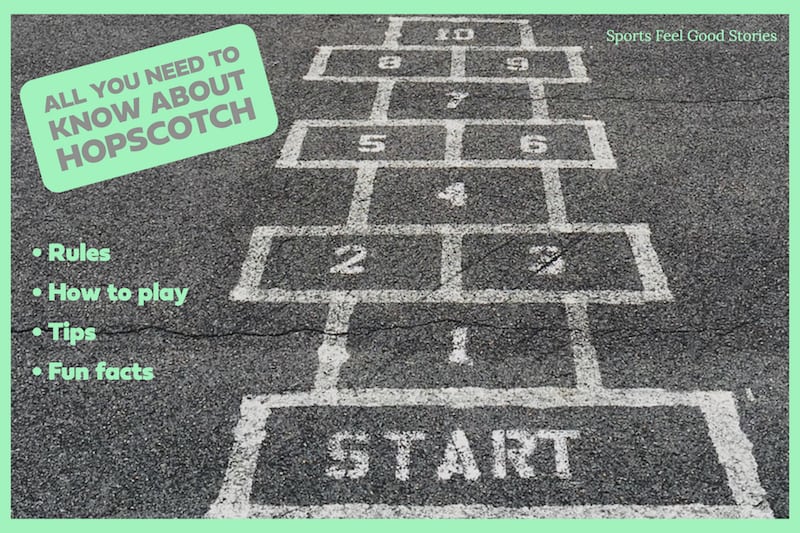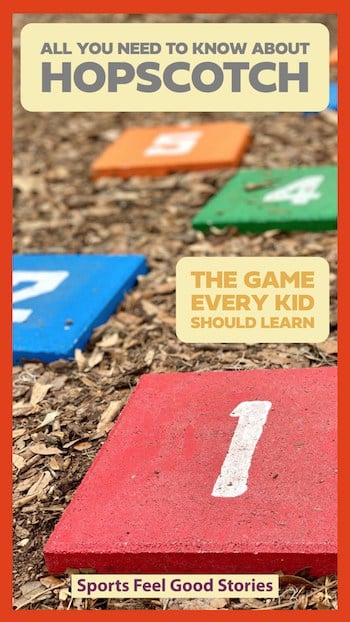Understanding how to play hopscotch, rules, and some simple strategies are almost a childhood right.
Hopscotch is like a trip down memory lane for many adults. It’s that worldwide game you learned in the neighborhood that everyone seems to know no matter where they grew up.
Do you remember marking the court with chalk, tossing a rock, and jumping through hopscotch boxes? Of course, not everyone played the same game the same way, but game variations were more alike than different. The universal game was a straightforward and fun childhood activity, whether by yourself or with friends.
How To Play Hopscotch
The court can be scratched out in the dirt with a stick or colorfully drawn out with chalk on the sidewalk. Part of the fun is just designing the court itself. Traditionally the court consists of a linear sequence of square boxes in sets of either 1 or 2. Each box is designed for a single foot, and the only way to get from the start to the end is to hop (no skipping, no stopping, no double-jumping).
A court features at least eight boxes, numbered 1 – 8, while many courts will have ten or even more boxes. Usually, there are just two sets of double boxes. At the end of the court is a safe zone marked with a larger square or semi-circle. Whoever turns it hops to the secure area, turns around, and hops back to the start. Each square is about an 18″ square (one and a half feet).

Hopscotch Rules
Here’s how the game is played. Before a player takes their turn, they toss a small stone, small bean bag, or bottle cap onto the court and claim a square. The square is contended by the stone landing inside the four lines but not touching the edges.
The player then proceeds to hop down the court, skipping over the ‘marked square’ with their stone and trying to avoid stepping on a line. If a player steps on a line, they lose the turn and the next player proceeds. Upon the return trip, the player stops in the square just before the marked court, bends over to pick up the rock, then finishes hopping.
The stone or bottle cap, known as a marker or a shooter, is tossed first in the first box. Players can throw their shooter again when they complete the trip up and down the court. This time, the target is the second box. For side-by-side squares, the player lands both feet – one in each square. The player lands just one foot in the square for single squares and elevates the other leg from the ground — think how a flamingo stands.
Play continues until an error occurs (foot touches a line, shooter misses a square, etc.), and then it is the next player’s turn. A player wins by completing a lap up and down the court after marking each numbered square—the first player to complete the course wins.
You might enjoy Get To Know The Four Square Game.
Hopscotch Variations
While those may be the traditional rules, hopscotch has always been a childhood favorite because it is ripe with variations and creative rule changes. The fun begins with drawing the court itself and deciding what patterns and combinations of double boxes and single boxes. If the chalk is used, it isn’t uncommon to see colorful variations across the boxes that may or may not have anything to do with the rules.
Even pure aesthetics can develop a set of rules: a yellow box can have a different requirement from a blue box. Sometimes boxes are of various sizes, requiring an extra-large leap if the box is big or an extra precise landing if the box is small. And sometimes they aren’t boxes at all. Any shape will do.
You might like Dodgeball: How to Play, Rules, Strategy.
French Variation
In France, the game is called Escargot (which means snail), and the game is played with a spiral court — the shape of a snail. The players toss a marker, then hops from the outside of the spiral to the last square before turning around and jumping back to the start.
X Marks The Spot Variation
One common variation that some people consider a standard modification to the court is to draw a large box that could fit four normal-sized boxes in it. The large box has an X drawn through the middle, which divides it into four sections. These diagonal lines follow the same rules as the rest of the game but pose a unique challenge when tossing and hopping.
Kick the Marker Variation
Instead of tossing your marker, e.g., a small rock, a player must kick it to land in the designated square. For most players, this will make it a little more complicated.
Australia Variation
In Australia, hopscotch is played in three stages. The first stage is the traditional way of playing, but after completing the first stage, the player jumps through the course, landing both feet in each square. The final step is much like the second stage, except the player must cross their legs while jumping, making it the most challenging phase. One mistake, and the player is forced to start over at step 1.
Check out Kickball Rules and Tips.
Speed Hopscotch Variation
Speed hopscotch requires each player to complete a lap within a specified time, e.g., 25 seconds. A watch or smartphone is used to keep time, and if the player fails to construct one lap in the designated amount of time, the player loses their turn.
Indoor Hopscotch Variation
Take the game indoors if rain, snow, or cold weather keeps you indoors. Use masking tape instead of chalk and a small beanie baby-like toy for the marker.
Hopscotch Game Tips
- It usually works out best to identify a flat surface for the court. On a hot day, you might also consider finding a spot with some shade.
- Sidewalk chalk is a great way to diagram out the court. If you’re playing with young kids, show them the hopscotch pattern or diagram on the paper, but let them draw it out on the driveway, sidewalk, or asphalt.
- Make sure the squares are big enough for feet to fit in them.
- For younger players, consider having them hop through the squares without having a marker to pick up.
- Adults provide some initial direction, but let kids work out disputes independently.

Playing Hopscotch For Fun
Sometimes the game has been less about the rules and more about fun and creativity. I think everyone has at least one memory of a hopscotch court that seemingly stretched on forever (I still remember the time the neighbor kids created a 100-square court). Or a choose-your-own-adventure court that branched off into different directions. Or boxes that were labeled with ABCs instead of numbers.
When it comes down to it, hopscotch can resemble a game where an object is thrown into an area with figures on the ground, and the player then hops through the figures and back again to retrieve the object.
Even when playing by yourself, the game can take on a variety of fun twists. One way is to continually drop and pick up the marker into the square in front of you to complete the court. One mistake sends you hopping back to the start.
Not many children are overly concerned with their physical fitness; they’d prefer to play and have fun. But to the adult mind, there is undoubtedly a proper balance and core strength that goes into just a simple trip up and down the boxes. Not to mention bending over and picking up a bottle cap while balancing on one foot. I’m not saying it’s a replacement for your yoga or pilates, but it’s nothing to shrug off, either.
So next time you walk down the sidewalk and see a hopscotch court- you know what to do.
Why is it called Hopscotch?
The English term “hopscotch” comes from the combination of the word “hop,” meaning to jump, and “escocher,” a French term meaning to cut. The word butterscotch also comes from this old French term. Butterscotch candy is made in big sheets and then “scotched” into bite-size pieces.
What is Hopscotch called in other Countries?
- Argentina = Rayuela
- Brazil = Amarelinha
- Chile = Luche
- Cuba = Pon
- France = Marelles
- Germany = Himmel und Holle
- Ghana = Tumatu
- India = Kith-Kith
- Scotland = Peevers
- Vietnam = Pico
- Note: In New York City, a game similar to hopscotch is played called Potsy. The marker is usually a flattened soft drink can.
Hopscotch Fun Facts
- It was initially called Scotch Hoppers and was played using wood floorboards instead of drawn boxes.
- According to Webster’s, the first known English noun officially describing the word “hopscotch” is traced back to in 1801
- The world record for the fastest game of hopscotch is held by Ashrita Furman, who finished a game in just 1 minute and 8 seconds, according to the Guinness Book of World Records.
- The original hopscotch courts were over 100 feet long! There were used for training exercises for the military in Britain. Roman soldiers ran through the court in full armor to improve their footwork.
- Nearly every country in the world plays hopscotch. It goes by many names, but the rules are always similar. Here are a few of the differences.
- In Germany, it is called Himmel und Holle which means heaven and hell. The last square is called heaven, and the second to last square is hell. Neither the marker nor the player is supposed to touch the square named hell.
Hopscotch Trivia
The name in India is Kith-Kith, which focuses on throwing the marker into a correct square.
In Iran, the game is called Laylay and is always played with an even number of squares. The marker is a flat stone and is kicked along to the next square as the player hops through.
The word “London” is sometimes written at the top of hopscotch courts, referencing the Great North Road that ended in London.
In Scotland, the game is called Peevers. In this case, the game takes the name of the marker and not the court. Many games are like this: the name is derived from the ball and not the field, e.g., basketball, football, and baseball.
In Edinburgh, Scotland, a hopscotch game board with nearly 1,400 squares was created to follow social distancing rules.
Hopscotch Benefits
Kids learn gameplay, how to follow the rules, and how to take turns when playing hopscotch. Physical benefits include improved coordination, foot-to-eye skills, hand-eye coordination, body control, and balance. Hopping on one foot also develops some muscle strength. Plus, it’s an excellent game for kids to develop social skills as they’re in close contact with some downtime between turns.
A sense of sportsmanship may also be acquired by playing with friends. Like hide-and-seek and kickball, hopscotch is just one of those games that everyone seems to have played at one point in their lives. So, get your kids started and let them enjoy the fun!
By Claire Evans
Claire writes about parenting, youth sports, and crafts. She lives in St. Paul, Minnesota.
Overtime
You’re on the How to Play Hopscotch, Rules, Tips, Fun Facts page.
You might like:
Surefire ways to win at ping-pong
